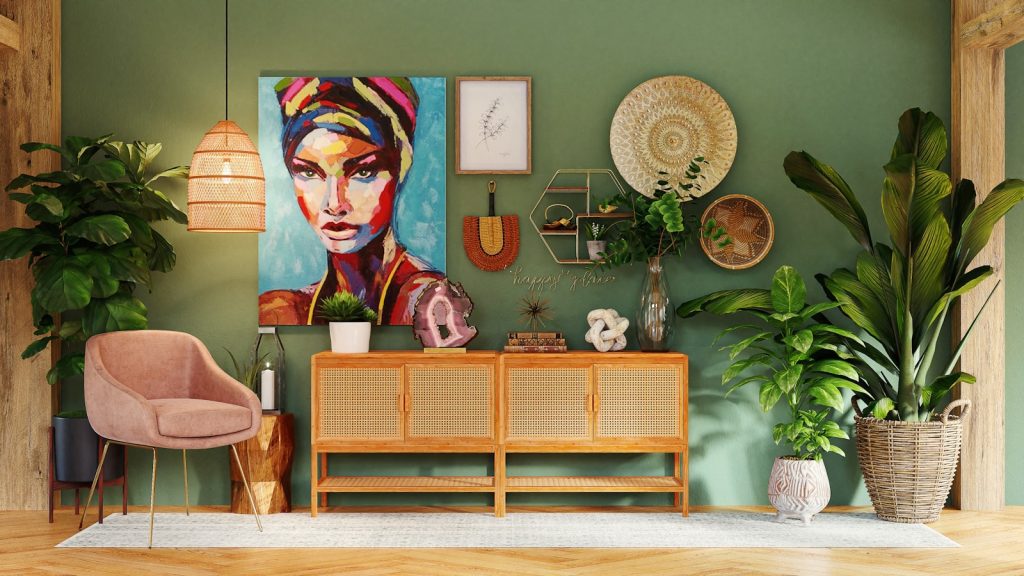In today’s fast-paced world, our homes have become sanctuaries where we seek comfort, peace, and a connection to nature. Eco-Textures in Interior Design offer a harmonious blend of sustainability and sensory engagement, transforming living spaces into nurturing environments. This approach emphasizes the use of natural, eco-friendly materials that not only reduce environmental impact but also enhance the tactile and visual experience of a room.
Historically, natural materials have been integral to home construction and design. From adobe walls in the Southwest to bamboo structures in Asia, these materials were chosen for their availability and harmony with the environment. Today, there’s a resurgence in using such materials, driven by a growing awareness of environmental issues and a desire for healthier living spaces. Eco-Textures in Interior Design embody this shift, focusing on materials and textures that are both sustainable and sensorially enriching.
Defining Eco-Textures in Interior Design
Eco-Textures in Interior Design refer to the incorporation of sustainable, natural materials that add tactile and visual depth to interior spaces. These textures engage the senses, creating environments that feel grounded and connected to the natural world. Unlike synthetic materials, eco-textures often have irregularities and variations that add character and warmth to a space.
Common Sustainable Materials Used
Several natural materials are commonly used to introduce eco-textures into interior design:
Bamboo: A fast-growing, renewable resource, bamboo is used for flooring, wall coverings, and furniture. Its smooth texture and light color bring a sense of calm and openness.
Jute: This durable, biodegradable fiber is often used in rugs and upholstery. Its coarse texture adds a rustic charm to interiors.
Raw Clay: Used in wall finishes and tiles, raw clay provides a soft, earthy texture that regulates humidity and adds warmth.
Cork: Harvested from the bark of cork oak trees without harming them, cork is used for flooring and wall panels. Its spongy texture offers comfort and insulation.
Reclaimed Wood: Repurposed from old structures, reclaimed wood brings history and a rich, uneven texture to furniture and flooring.
Psychological and Emotional Impact of Tactile Design
Textures play a significant role in how we perceive and feel in a space. Natural textures can evoke feelings of comfort, relaxation, and connection to nature. According to a study published in the Journal of Environmental Psychology, tactile experiences with natural materials can reduce stress and enhance mood. The irregularities and imperfections in materials like wood and stone provide a sensory richness that synthetic materials often lack.
Reducing Synthetic Consumption
Incorporating eco-textures helps reduce reliance on synthetic materials, which are often derived from non-renewable resources and can emit harmful chemicals. By choosing natural, biodegradable materials, homeowners can create healthier indoor environments and contribute to environmental sustainability.
Examples of Eco-Textures in Different Rooms
Living Room: A reclaimed wood coffee table paired with a jute rug and linen curtains creates a cozy, inviting space.
Bedroom: Bamboo flooring, organic cotton bedding, and a cork headboard add warmth and tranquility.
Kitchen: Clay tile backsplashes and wooden countertops bring an earthy, grounded feel.
Bathroom: Stone sinks and bamboo bath mats introduce natural textures that enhance relaxation.
Second Half of the Main Body
Sourcing Eco-Friendly Textured Materials Responsibly
When selecting materials, it’s essential to consider their environmental impact. Look for certifications like FSC (Forest Stewardship Council) for wood products, which ensure sustainable harvesting practices. Choose local materials to reduce transportation emissions, and opt for products made with non-toxic finishes and adhesives.
DIY vs. Professional Eco-Texture Installations
DIY projects can be a cost-effective way to incorporate eco-textures, such as installing a cork bulletin board or creating a jute wall hanging. However, for larger installations like flooring or wall treatments, hiring professionals ensures proper installation and longevity. Professionals can also provide guidance on the best materials for specific applications and climates.
Combining Textures with Color and Light for Natural Ambiance
The interplay of texture, color, and light significantly influences the ambiance of a space. Soft, neutral colors enhance the natural feel of materials like wood and linen, while strategic lighting can highlight textures and create depth. For instance, placing a spotlight on a textured clay wall can accentuate its surface variations, adding visual interest.
Success Stories and Expert Tips
Interior designer Sarah Barnard emphasizes the importance of integrating natural textures to create spaces that promote well-being. In one project, she combined reclaimed wood beams with clay plaster walls and wool textiles to craft a serene, eco-friendly living room. Her approach demonstrates how thoughtful material selection can transform a space both aesthetically and functionally.
Potential Mistakes and How to Avoid Them
Overloading with Textures: Too many competing textures can make a space feel chaotic. Aim for balance by mixing smooth and rough textures thoughtfully.
Neglecting Maintenance: Natural materials may require specific care. For example, untreated wood can be susceptible to moisture damage. Ensure proper sealing and regular maintenance.
Ignoring Compatibility: Not all textures complement each other. Consider the overall design theme and choose materials that harmonize in color and style.
Conclusion
Eco-Textures in Interior Design offer a pathway to creating homes that are not only environmentally responsible but also rich in sensory experiences. By embracing natural materials, homeowners can craft spaces that promote well-being, reflect personal values, and contribute to a more sustainable future. The integration of eco-textures is more than a design choice; it’s a lifestyle commitment to harmony with the natural world.

